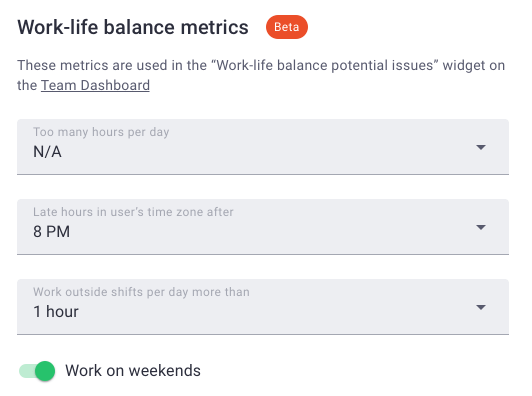Employee wellness and the employee experience have quickly become a major focus for many organizations since the onset of the pandemic. In a 2020 survey by Spring Health, 76% of U.S. employees reported that they were experiencing burnout.
With such a dramatic majority of employees suffering from symptoms of burnout, encouraging a healthy work-life balance and making efforts to reduce employee burnout should be a top concern for companies.
There are many factors that can affect an employee’s wellbeing. Everything from a lack of recognition to not having clear goals and expectations can derail an employees work-life balance and negatively impact their wellbeing. With so much to keep track of, employers need tools that can help them better understand their workforce.
Time Doctor is excited to launch our new Work-life Balance Widget that will help organizations spot signs of burnout and work-life balance issues faster, so that employees can be more productive, engaged and happier.
The work-life balance widget

Time Doctor’s new Work-life Balance widget will be added to our Team Dashboard for administrators and managers to quickly identify the employees that are at the highest risk for burnout due to poor work-life balance.
Employees that show up on our new Work-life Balance widget have a minimum of 5 potential work-life balance issues out of a 30 day time period. The total number of issues, plus details on the types of issues found, are shown on the new widget.
We’re identifying work-life balance issues when employees:
- Work too many hours per day
- Work too many late hours
- Work too many hours outside of scheduled shifts
- Work on the weekends
Administrator roles in Time Doctor are 100% in control of the work-life balance metrics. Admins have the ability to set these metrics based on what their company considers to be too much. In the example below, this company has decided that working after 8pm and on the weekends could indicate that a healthy work-life balance is at risk.

The impact of poor work-life balance
Employees are a company’s most important asset, making employee engagement and wellbeing a top priority for most organizations. Companies who don’t support and foster a good work-life balance will quickly see the negative impact on employees which ultimately, leads to low employee engagement and high churn rates.
Several studies including research from the Mayo Clinic, Hubspot, and the Harvard Business Review list the biggest consequences of overworking employees are:
- Decreased productivity
- Increased errors
- Lack of engagement and interest in their job
- Mental and physical health issues
- High turnover
Along with the list above, employees who are experiencing burnout have higher levels of absenteeism and lower quality of work which can impact the overall success and growth of your organization.
Solving work-life balance issues
Once leaders and managers have identified the employees with the most work-life balance issues, they can begin to create an action plan that will help encourage more separation from work. This will lead to increased employee engagement and retention and ultimately higher company performance overall.
Some tips for companies to encourage more work-life balance are:
- Promote more flexible schedules – Allow employees to find when they are the most productive and adjust their schedule when possible to their ideal work hours. Recognize that on some days, team members may be able to get all of their work done in less hours, giving them more time to focus on themselves.
- Regularly review workloads– Make sure that some employees aren’t tasked with significantly more than other employees with similar roles. Time Doctor makes this easier with our Projects and Tasks report that gives your Managers insight into what is being worked on.
- Encourage more breaks – Remind employees know that it’s perfectly ok to get up and take a walk or go run an errand. They can come back more refreshed and ready to focus.
- Set clear and attainable goals – Make sure it is clear to employees what they need to do to succeed or how to accomplish tasks. Without that direction, employees will often struggle with stress and work longer hours.
- Reward and recognize top talent – By consistently recognizing the hard work and the value that employees bring to your company, engagement will remain high leading to increased productivity and efficiency.
- Lead by example – Ensure that leadership and managers aren’t working every weekend or consistently reaching out to team members during late hours. When employees see this consistently with their leaders they can feel pressured and even guilty that they aren’t working enough.

With Time Doctor’s data, we can arm you with the insights you need to stay in front of these serious work-life balance and burnout issues, ensuring that your teams stay productive and happy.
Want to see a preview of the new Work-Life Balance widget plus our other insights that can help you reduce employee burnout? Click here for an exclusive tour of this new feature.

Amy Owens is a product marketing enthusiast with a passion for writing content that communicates the features, values, and benefits of products.


